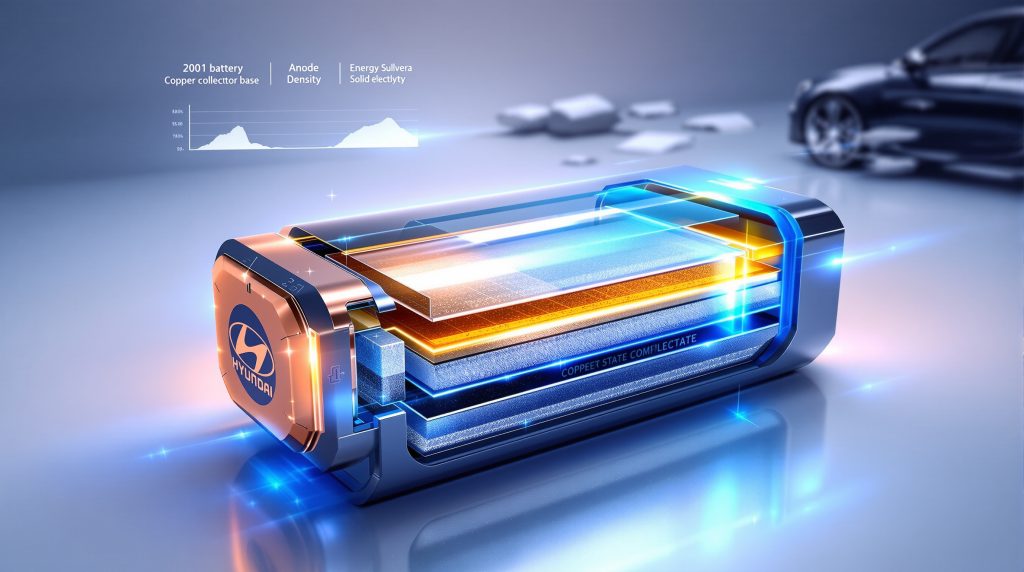Hyundai's Copper Breakthrough in Solid-State Batteries: Innovation, Impact, and Industry Implications
Solid-state battery technology represents the next frontier in electric vehicle development, promising greater safety, higher energy density, and faster charging capabilities. Among the many companies racing to commercialize this technology, Hyundai has emerged with a potentially game-changing innovation that could accelerate the timeline for mass adoption.
What Is Hyundai's New Solid-State Battery Patent?
The Copper Innovation Explained
Hyundai has filed a groundbreaking U.S. patent application that enables the use of copper within sulphide-based solid-state batteries. This innovation represents a significant technical advancement, as copper has traditionally been incompatible with sulphide electrolytes due to their highly corrosive nature. The technology involves applying a specialized protective coating over a copper anode current collector, creating a buffer that prevents degradation while maintaining copper's superior conductivity properties.
The significance of this breakthrough cannot be overstated. Sulphide-based solid electrolytes have shown tremendous promise for next-generation batteries but have been limited by material compatibility issues. By solving the copper corrosion problem, Hyundai may have removed a critical barrier to commercial viability.
Key Technical Components of the Patent
The protective buffer layer consists of a carbon sheet with oriented carbon materials—potentially including vertically aligned carbon nanotubes—combined with lithiophilic metal particles such as silver, gold, or aluminum. This porous structure maintains stability even during full charge cycles and helps distribute lithium more uniformly, preventing concentrated deposition at anode edges that typically leads to performance degradation.
The technical innovation lies in the precise composition and structure of this buffer layer:
- Carbon matrix provides structural integrity and initial protection
- Oriented carbon materials create pathways for efficient electron movement
- Lithiophilic particles encourage even lithium distribution during cycling
- Porous architecture accommodates volume changes during charge/discharge
This multi-component approach represents a sophisticated solution to what has been a persistent technical challenge in solid-state battery development.
Why Is Copper Important for Solid-State Batteries?
Copper's Advantages in Battery Design
Copper offers several critical advantages over the nickel and stainless steel alternatives currently used in solid-state batteries:
- Superior electrical conductivity: Copper conducts electricity approximately 60% more efficiently than nickel, reducing internal resistance and improving overall battery performance
- Cost efficiency: Copper typically costs $8,000-9,000 per ton compared to nickel at $20,000-25,000 per ton, representing significant potential savings
- Established supply chains: Already widely used in conventional lithium-ion batteries, meaning manufacturing infrastructure exists
- Thermal management: Better heat dissipation properties, crucial for fast-charging applications
- Weight reduction: Lighter than stainless steel alternatives, contributing to overall vehicle efficiency
These advantages collectively represent a compelling case for copper's integration into solid-state battery designs, if the corrosion challenges can be overcome. Recent copper price insights suggest that strategic material planning will be crucial for manufacturers adopting this technology.
Current Material Limitations in Solid-State Batteries
Solid-state battery manufacturers have been forced to use less conductive and more expensive materials like nickel alloys and stainless steel to withstand the corrosive effects of sulphide electrolytes. This material compromise has contributed to higher production costs and reduced performance efficiency, creating barriers to mass commercialization of solid-state technology.
"The corrosive nature of sulphides has forced manufacturers to compromise on conductivity and cost, using nickel or stainless steel instead of the copper that conventional lithium-ion batteries rely on for effective electron transfer." – Battery Industry report
These material limitations have created several challenges:
- Higher internal resistance reducing power output
- Increased material costs affecting economic viability
- Additional manufacturing complexity
- Thermal management issues during fast charging
Hyundai's innovation potentially addresses all these limitations simultaneously.
How Does Hyundai's Technology Work?
The Layered Architecture Design
The patent describes a sophisticated multi-layer structure that enables copper's integration:
- Copper current collector (base layer)
- Protective carbon-based buffer coating with lithiophilic particles
- Anode material layer
- Solid sulphide electrolyte
- Cathode material
- Terminal collector
This layered architecture creates a battery that leverages copper's advantages while protecting it from degradation. The carbon-based buffer coating serves as the critical innovation, acting as a protective barrier while still allowing efficient electron transfer between the copper current collector and the anode material.
Performance Enhancements Through Protective Mechanisms
The protective coating delivers several functional benefits:
- Enhanced adhesion: The buffer layer creates stronger bonding between the copper collector and anode materials, improving durability during cycling
- Corrosion resistance: The carbon matrix prevents direct contact between copper and corrosive sulphide electrolytes
- Cycle stability: The structure maintains capacity over more charge-discharge cycles by preventing material degradation
- Uniform lithium distribution: Lithiophilic particles help suppress uneven lithium deposition that can lead to dendrite formation
- Mechanical stability: The porous structure accommodates volume changes during charging and discharging
These protective mechanisms work in concert to overcome the historical limitations of copper in solid-state battery applications, potentially enabling a significant leap forward in performance and cost-efficiency. The industry is also closely watching recent battery recycling breakthroughs that could complement this technology.
What Are the Potential Benefits for Electric Vehicles?
Performance Improvements
The integration of copper into solid-state batteries could deliver significant performance enhancements for EVs:
- Higher energy density: More efficient electron transfer leads to improved energy storage, potentially increasing from current 250-300 Wh/kg to 400-500+ Wh/kg
- Faster charging capabilities: Better conductivity enables quicker electron movement during charging, potentially reducing 20-80% charging times from 30+ minutes to under 15 minutes
- Extended battery lifespan: More uniform cycling reduces degradation mechanisms, potentially extending useful life from 1,000-2,000 cycles to 2,000-3,000+
- Improved temperature performance: Better thermal management in extreme conditions, expanding the operational temperature range by 15-20%
- Reduced battery weight: Higher energy density allows for smaller, lighter battery packs for the same range
For electric vehicle owners, these improvements could translate to longer range, shorter charging stops, and reduced range anxiety—addressing the primary concerns that have limited EV adoption.
Cost Reduction Implications
The financial impact of this technology could accelerate solid-state battery adoption:
- Lower material costs: Copper is approximately 4-6 times less expensive than nickel, potentially reducing current collector costs by 70-80%
- Simplified manufacturing: Potential for adapting existing lithium-ion production infrastructure that already uses copper collectors
- Reduced battery replacement costs: Longer-lasting batteries decrease lifetime ownership expenses by 20-30%
- Scale economies: Easier path to mass production with more accessible materials
- Lower total pack cost: Combined material and manufacturing efficiencies could help drive solid-state battery costs below $100/kWh—the threshold for price parity with internal combustion vehicles
These cost reductions could prove critical in transitioning solid-state batteries from premium vehicles to mass-market applications, potentially accelerating electric vehicle adoption globally. Moreover, improved battery metals investment trends suggest growing financial support for these innovations.
How Does This Compare to Current Battery Technologies?
Solid-State vs. Conventional Lithium-Ion Batteries
This table highlights key differences between battery technologies:
| Feature | Conventional Li-ion | Current Solid-State | Hyundai's Copper-Enhanced Solid-State |
|---|---|---|---|
| Electrolyte | Liquid | Solid | Solid |
| Current Collector | Copper | Nickel/Stainless Steel | Copper with protective coating |
| Energy Density | 250-300 Wh/kg | 400-500 Wh/kg | Potentially 500+ Wh/kg |
| Safety | Risk of thermal runaway | Higher safety margin | Higher safety margin |
| Charging Speed | 20-80% in 30+ min | Potential for 20-80% in 15 min | Potentially faster with copper conductivity |
| Production Cost | Lower | Higher | Reduced compared to current solid-state |
| Cycle Life | 1,000-2,000 cycles | 1,000-3,000 cycles | Potentially extended with buffer technology |
| Cold Weather Performance | Degraded | Improved | Improved with better conductivity |
| Operating Temperature Range | Narrower | Wider | Wider with enhanced thermal management |
| Weight | Heavier | Lighter | Lighter with copper efficiency |
Competitive Advantages in the Solid-State Landscape
Hyundai's approach offers distinct advantages compared to other solid-state battery development efforts:
- Material innovation vs. structural design: While competitors focus on electrolyte composition, Hyundai addresses interface engineering between components
- Practical manufacturing considerations: Design leverages existing production knowledge from conventional batteries
- Cost-performance balance: Addresses both technical performance and economic viability simultaneously
- Evolutionary approach: Builds on existing technology rather than requiring completely new manufacturing paradigms
- Supply chain readiness: Utilizes materials with established global supply networks
This balanced approach may prove more practical for near-term commercialization compared to more radical redesigns being pursued by some competitors. Understanding the global copper supply forecast will be essential for scaling this technology.
What Is Hyundai's Broader Solid-State Battery Strategy?
Multi-Pronged Development Approach
Hyundai is pursuing solid-state battery technology through several parallel initiatives:
- Internal R&D: Pilot production line at Uiwang Research Institute initiated in January 2025
- Strategic partnerships: Collaborations with specialized battery developers including SES AI and Factorial Energy
- Academic research: Ongoing collaboration with Seoul National University on fundamental solid-state technology
- Patent portfolio expansion: Multiple patent applications covering various aspects of solid-state technology
- Technology acquisition: Strategic investments in startups with complementary innovations
This diversified approach spreads risk across multiple technology pathways, increasing Hyundai's chances of achieving commercial viability regardless of which specific solid-state chemistry ultimately proves most successful.
Timeline for Commercial Implementation
While specific commercialization dates haven't been announced, Hyundai's development activities suggest a structured path to market:
- Research phase: Completed with multiple patent filings and university partnerships
- Pilot production: Already underway at research facilities
- Vehicle testing phase: Likely within 1-2 years based on development progress
- Initial commercial applications: Potentially in premium vehicle segments first (2027-2028)
- Mass-market integration: Dependent on production scaling and cost optimization (2028-2030)
This timeline aligns with industry projections that place the first commercial solid-state batteries in production vehicles around 2027, though Hyundai's copper innovation could potentially accelerate this schedule.
What Challenges Remain for Commercialization?
Technical Hurdles
Despite the breakthrough, several challenges must still be addressed:
- Manufacturing scalability: Transitioning from laboratory to mass production requires precise control of the buffer layer application process
- Long-term durability verification: Ensuring the protective coating maintains integrity over thousands of cycles and years of operation
- Interface stability: Managing the complex interactions between different material layers under various operating conditions
- Temperature performance range: Validating operation across extreme automotive conditions from -40°C to +60°C
- Quality control: Developing inspection methods to ensure consistent coating application across thousands of battery cells
These technical challenges are substantial but represent engineering problems rather than fundamental scientific barriers, suggesting they can be overcome with focused development efforts.
Industry Adoption Factors
Broader market implementation will depend on:
- Industry standardization: Alignment with emerging solid-state battery standards for safety, performance, and integration
- Supply chain development: Establishing specialized material supply networks for advanced carbon structures and lithiophilic particles
- Production equipment adaptation: Modifying manufacturing processes for the new design
- Regulatory certification: Meeting safety and performance requirements for automotive use
- Consumer acceptance: Demonstrating reliability and performance advantages to overcome early adoption concerns
The complexity of these factors explains why most industry analysts project a gradual, staged introduction of solid-state technology rather than an immediate market disruption. Additionally, closed-loop battery recycling systems will need to adapt to these new material combinations.
How Does This Impact the Future of EV Batteries?
Market Implications
Hyundai's innovation could accelerate several market trends:
- Accelerated solid-state timeline: Potentially bringing commercial solid-state batteries to market 1-2 years sooner than previously projected
- Cost trajectory shifts: Faster price parity with conventional lithium-ion technology, potentially by 2028-2029
- Competitive positioning: Advantage for automakers with early access to the technology
- Supply chain realignment: Increased demand for copper in battery applications, potentially tightening global copper markets
- Battery recycling economics: Enhanced value proposition for end-of-life battery recycling due to higher copper content
These market dynamics could reshape investment priorities across the battery and automotive industries, potentially accelerating the transition away from conventional lithium-ion technology.
Environmental and Sustainability Considerations
The technology also offers potential environmental benefits:
- Resource efficiency: Better utilization of materials through higher energy density, requiring less raw material per kWh of storage
- Lifecycle improvements: Longer-lasting batteries reduce replacement frequency and associated manufacturing impacts
- Recycling compatibility: Copper has established recycling infrastructure with recovery rates exceeding 80% in many markets
- Energy consumption: More efficient electron transfer potentially reduces charging energy losses by 5-10%
- Manufacturing simplification: Potential for reduced chemical processing and solvent use in production
These sustainability advantages align with increasing regulatory pressure for more environmentally responsible battery production and lifecycle management.
Who Are the Key Players in Solid-State Battery Development?
Automotive Manufacturers
Several major automakers are actively developing solid-state technology:
- Toyota: Investing heavily with plans for production by 2027-2028, focusing on sulfide electrolytes with over 1,000 patents filed
- Volkswagen/QuantumScape: Partnership targeting production by 2025-2026, with $300 million invested in ceramic separator technology
- BMW/Solid Power: Collaboration for solid-state implementation in vehicle platforms by 2026
- Hyundai-Kia: Multi-partner approach with internal development and strategic partnerships
- Nissan: Working on proprietary solid electrolyte technology for potential 2028 deployment
These automotive manufacturers recognize that battery technology will be a key competitive differentiator in the coming decade, driving substantial investments in proprietary technology.
Battery Technology Companies
Specialized firms focusing on solid-state innovation include:
- QuantumScape: Silicon-based anode with ceramic separator, backed by Volkswagen and Bill Gates
- Solid Power: Sulfide-based electrolyte with high conductivity, partnered with BMW and Ford
- Factorial Energy: Proprietary FEST™ (Factorial Electrolyte System Technology) with multiple automotive partnerships
- SES AI: Hybrid lithium-metal approach with some liquid components, working with General Motors and Hyundai
- ProLogium: Oxide-based solid electrolyte technology with Mercedes-Benz partnership
These specialized companies represent various technological approaches to solid-state batteries, highlighting that multiple viable pathways may emerge in this rapidly evolving field.
FAQs About Solid-State Batteries and Hyundai's Innovation
What makes solid-state batteries different from conventional lithium-ion batteries?
Solid-state batteries replace the liquid electrolyte found in conventional lithium-ion batteries with a solid material. This fundamental change enables higher energy density, faster charging capabilities, and significantly reduced fire risk, as solid electrolytes are generally non-flammable and more stable across a wider temperature range.
The elimination of liquid components also allows for new cell designs and potentially thinner, lighter battery packs. This architecture change represents the most significant battery technology shift since lithium-ion batteries were commercialized in the early 1990s.
When will solid-state batteries be available in production vehicles?
Most industry projections indicate limited commercial availability in premium vehicles between 2026-2028, with broader implementation in mass-market models likely in the 2028-2030 timeframe. Hyundai's copper innovation could potentially accelerate this timeline if manufacturing challenges are successfully addressed.
Early deployment will likely focus on high-performance or premium vehicles where the technology's advantages justify higher initial costs. Mass-market adoption will depend on achieving production scale and cost reductions through manufacturing optimization.
How much improvement in driving range can be expected with solid-state batteries?
Solid-state batteries are projected to deliver 30-50% greater energy density compared to current lithium-ion technology. This could translate to EVs with 500+ miles (800+ km) of range without increasing battery size or weight, effectively addressing one of the primary consumer concerns about electric vehicles.
For context, a vehicle currently offering 300 miles of range could potentially reach 400-450 miles with solid-state technology of the same physical size. Alternatively, manufacturers could maintain current ranges while significantly reducing battery size, weight, and cost.
Will solid-state batteries solve the fast-charging limitations of current EVs?
Solid-state technology shows promise for significantly faster charging. While current EVs typically require 30+ minutes for a 20-80% charge, solid-state batteries could potentially reduce this to 10-15 minutes, approaching the convenience of refueling a conventional vehicle.
Hyundai's copper innovation is particularly relevant here, as copper's superior conductivity directly impacts charging speed. The protective buffer layer technology could enable the high current densities required for ultra-fast charging while preventing degradation mechanisms that typically occur under such conditions.
Are there environmental advantages to solid-state battery technology?
Beyond performance improvements, solid-state batteries may offer environmental benefits through longer cycle life (reducing replacement frequency), potentially simpler recycling processes, and the possibility of using less environmentally problematic materials compared to current lithium-ion formulations.
The higher energy density also means less raw material required per kWh of storage capacity, potentially reducing the overall environmental footprint of battery production. Additionally, improved safety reduces the risk of thermal events and associated environmental contamination.
Further Exploration
Readers interested in learning more about advancements in solid-state battery technology can explore related educational content available on Battery Industry's website and the U.S. Patent and Trademark Office public patent database.
As the technology evolves rapidly, following automotive manufacturer announcements and battery technology company developments will provide ongoing insights into commercialization timelines and performance capabilities. The race to bring solid-state batteries to market represents one of the most significant technology competitions in the automotive industry today.
Want to Stay Ahead of the Next Major Battery Metals Discovery?
Discover real-time alerts on significant ASX mineral discoveries with Discovery Alert's proprietary Discovery IQ model, turning complex data into actionable insights for copper and battery metals investors. Explore why major mineral discoveries can lead to exceptional returns by visiting our dedicated discoveries page.




